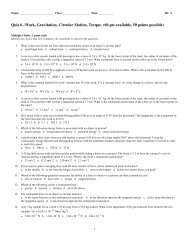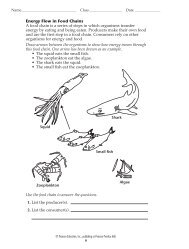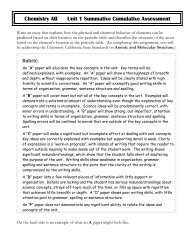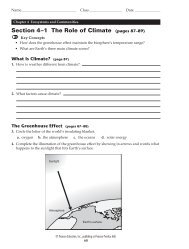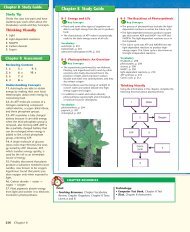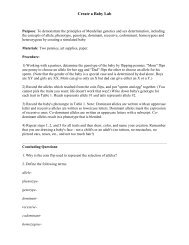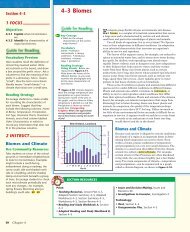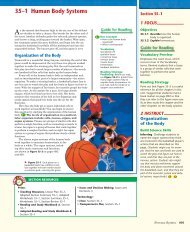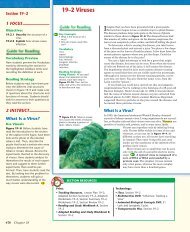Ch 40-1 Infectious Diseases - Downtown Magnets High School
Ch 40-1 Infectious Diseases - Downtown Magnets High School
Ch 40-1 Infectious Diseases - Downtown Magnets High School
- No tags were found...
You also want an ePaper? Increase the reach of your titles
YUMPU automatically turns print PDFs into web optimized ePapers that Google loves.
<strong>40</strong>–1 <strong>Infectious</strong> DiseaseSection <strong>40</strong>–1Good health is something that you might take for granted—until you or someone close to you gets sick. Then, the value ofgood health becomes all too obvious. Why do you get sick? Howdo you get better? What is the best way for you to avoid gettingsick in the first place? These are questions that people havebeen asking for centuries. Today, in most cases, these questionscan be answered.A disease is any change, other than an injury, that disruptsthe normal functions of the body. Some diseases areproduced by agents, such as bacteria, viruses, and fungi.Others are caused by materials in the environment, suchas cigarette smoke. Still others, such as hemophilia, areinherited. Disease-causing agents are called pathogens,which means “sickness-makers.” <strong>Diseases</strong> caused by pathogensare generally called infectious diseases.The Germ Theory of DiseaseFor thousands of years, people believed that diseases werecaused by curses, evil spirits, or night vapors. In the midnineteenthcentury, a new explanation was put forth based onthe work of the French chemist Louis Pasteur and the Germanbacteriologist Robert Koch. The observations of Pasteur andKoch led them to conclude that infectious diseases were causedby microorganisms of different types, commonly called germs.This idea is now known as the germ theory of disease.The world is filled with microorganisms of every shape anddescription. How can scientists be sure that a particular organismcauses a certain disease? In 1975, Allen Steere of Yale Universityhad a chance to ask that question. In a small area of Connecticut,Steere found 39 children and several adults suffering from painand joint inflammation. Their symptoms looked like arare form of childhood arthritis. However, Steere thoughtthat there were far too many cases of arthritis for such asmall population. He looked for another explanation. Therural location of the outbreak and the fact that most ofthe cases had started in summer or early fall made Steeresuspect, at first, that this could be an infectious diseasecarried by an insect.Print:Key Concepts• What causes disease?• How are infectious diseasestransmitted?Vocabularydiseasepathogengerm theory of diseaseKoch’s postulatesvectorantibioticReading Strategy:Using Prior KnowledgeBefore you read, make a list ofsome of the diseases that youhave had. As you read, determinewhich pathogen mighthave caused each disease.Figure <strong>40</strong>–1 <strong>Diseases</strong> can be inherited,caused by materials in the environment, orproduced by pathogens. Certain species ofticks often carry bacteria or viruses that aretransmitted when they bite a host. (magnification: about 30)SECTION RESOURCES• Laboratory Manual A, <strong>Ch</strong>apter <strong>40</strong> Lab• Teaching Resources, Lesson Plan <strong>40</strong>–1,Adapted Section Summary <strong>40</strong>–1, SectionSummary <strong>40</strong>–1, Worksheets <strong>40</strong>–1, SectionReview <strong>40</strong>–1• Reading and Study Workbook A, Section<strong>40</strong>–1• Adapted Reading and Study Workbook B,Section <strong>40</strong>–1TimeSaver• Biotechnology Manual, Lab 16Technology:• iText, Section <strong>40</strong>–1• BioDetectives DVD, “Influenza: Tracking aVirus”; “Hantavirus: A Tale of Mice andPeople”• Transparencies Plus, Section <strong>40</strong>–11 FOCUSObjectives<strong>40</strong>.1.1 Identify the causes of disease.<strong>40</strong>.1.2 Explain how infectious diseasesare transmitted.<strong>40</strong>.1.3 Describe how antibioticsfight infection.Vocabulary PreviewTell students that the term pathogenrefers to an agent that causes disease.Ask: How do you think theterm pathogen is related to thegerm theory of disease? (Germ isanother term for pathogen. Accordingto the theory, germs, or pathogens,cause disease.)Reading StrategyStudents are likely to list respiratoryinfections such as colds and flu andgastrointestinal infections that causestomachaches and diarrhea. Theyshould determine which pathogenmight have caused each disease.2 INSTRUCTAddress MisconceptionsExplain that some diseases have multiplecauses. For example, some types ofcancer, such as lung cancer, are causedby environmental factors, for example,cigarette smoke. Other types of cancer,such as cervical cancer, are causedby pathogens (for cervical cancer,human papilloma virus).The Germ Theoryof DiseaseDemonstrationHelp students appreciate the importanceof the germ theory of diseaseby showing them death rates bycause of death in the United Statespopulation for the late 1800s andalso for a recent year. Then, ask: Howdid the number of deaths causedby infectious diseases change? (Itfell dramatically.) Add that identifyinggerms as the cause of infectious diseaseswas the first step in bringingthese diseases under control.The Immune System and Disease 1031
<strong>40</strong>–1 (continued)Koch’s PostulatesDemonstrationDemonstrate the importance of usingsterile techniques when applyingKoch’s second postulate. Hold a wireloop in the flame of a Bunsen burnerfor a few seconds. Allow the loop tocool, dip it in a bacterial culture, andrun it over sterile agar in a petri dish.(CAUTION: Use a safe strain of bacteria,such as E. coli, from a scientificsupply company, and apply steriletechniques to the handling of thebacterial culture.) Sterilize the loopagain, let it cool, and run it over sterileagar in a second petri dish.Incubate both dishes at 37°C for 24hours, and then have studentsobserve the differences in the agar.(Bacteria should be visible growing inthe first petri dish but not the second.)Ask: Which step of the demonstrationcaused the different outcomesin the two petri dishes? (The resterilizationof the wire loop) How doesthis demonstration relate to Koch’ssecond postulate? (If you had beentrying to isolate and grow a pathogenin the petri dishes, only the second dishwould produce a pure culture. The firstpetri dish would have produced bacteriain addition to the pathogen.)Pathogen (Borrelia burgdorferi) identifiedPathogen grown in pure culturePathogen injected into healthy lab mouseHealthy mouse becomes sickPathogen (Borrelia burgdorferi) recovered Figure <strong>40</strong>–2 Allen Steere followedKoch’s postulates to test his theorythat the bacterium Borrelia burgdorfericaused Lyme disease. Inferring Whymust the pathogen be grown in a pureculture?Sure enough, many of the children reportedthat their problems began with what they thoughtwas an insect bite. The bite was followed by anexpanding skin rash. Steere called the infectionLyme disease after the town of Lyme,Connecticut, where it was first discovered.Steere and his colleagues were able to linkthe skin rash to the bite of the tiny deer tick(Ixodes scapularis). One of Steere’s colleagues,Dr. Willy Burgdorfer, found an unusual spiralshapedbacterium (Borrelia burgdorferi) in theticks. Steere found the same bacterium inpatients with Lyme disease. Could this bacteriumbe the cause of Lyme disease?For ethical reasons, Steere did not try toinfect healthy children with the bacterium.However, when the bacterium was injected intolaboratory mice, they developed arthritis andother symptoms, just as the children had. Fromthe sick mice, Steere recovered the bacteria,which were then injected into healthy mice. Thehealthy mice then developed the disease. Steereand his colleagues had found the organism thatcaused Lyme disease. The process Steere used isshown in Figure <strong>40</strong>–2.Koch’s PostulatesThe groundwork for Allen Steere’s work withLyme disease was actually laid more than ahundred years earlier by Robert Koch. From hisstudies with various bacteria, Koch developed aseries of rules still used today to identify themicroorganism that causes a specific disease.These rules are known as Koch’s postulates.Koch’s postulates can be stated as follows:1. The pathogen should always be found in thebody of a sick organism and should not befound in a healthy one.2. The pathogen must be isolated and grown inthe laboratory in pure culture.3. When the cultured pathogens are placed in anew host, they should cause the same diseasethat infected the original host.4. The injected pathogen should be isolated fromthe second host. It should be identical to theoriginal pathogen.Why are these rules important? Becauseidentifying pathogens that cause disease is thefirst step toward preventing or curing the ailmentsthey produce.1032 <strong>Ch</strong>apter <strong>40</strong>UNIVERSAL ACCESSLess Proficient ReadersReinforce the material for less proficient readers byhaving them make posters that show ways infectiousdiseases can be spread and also how theirspread can be prevented. For example, studentsmight use a picture of two people shaking handsto illustrate the spread of diseases through physicalcontact and beside it a picture of someonewashing hands to prevent the spread of diseasesin this way.Advanced LearnersHave students who need extra challenges learnmore about Lyme disease. Students might investigatethe current distribution of the disease in theUnited States, the number of people who areinfected, how the disease is treated, and whetherit can be transmitted by other vectors. Studentsshould share what they learn in an oral reportillustrated with visuals, such as a map showing thedistribution of Lyme disease.
Agents of DiseaseFor many pathogens, the human body provides just the rightconditions for growth—a suitable body temperature, a wateryenvironment, and an abundance of nutrients. The large intestine,for example, harbors dense colonies of bacteria that help inthe process of digestion. Bacteria and yeast are also found in themouth and throat. Fortunately, most of these organisms areharmless, and many are actually beneficial.If this is true, then exactly how do pathogens cause disease?Some pathogens, including viruses and some bacteria, destroycells as they grow. Other bacteria release toxins that harm anorganism. Still others, especially parasitic worms, producesickness when they block the flow of blood, remove nutrientsfrom the digestive system, and disrupt other bodily functions.The Ascaris worm in Figure <strong>40</strong> –3 is a parasitic worm.Viruses Viruses are tiny particles that invade and replicatewithin living cells. Viruses attach to the surface of a cell, inserttheir genetic material in the form of RNA or DNA, and take overmany of the functions of the host cell. Viruses can infect nearlyevery type of organism—including plants, animals, and bacteria.<strong>Diseases</strong> caused by viruses include the common cold, influenza,smallpox, and warts.Bacteria Most bacteria are harmless to humans. Unfortunately,the few that are pathogens cause serious diseases. Bacteria causedisease in one of two ways—either by breaking down the tissuesof the infected organism for food or by releasing toxins that harmthe body. Bacterial diseases include streptococcus infections,diphtheria, botulism, and anthrax.Protists You may not associate protists with disease, but aprotist causes what may be the single most damaging infectiousdisease afflicting humans—malaria. Malaria is caused byPlasmodium, a protist that is spread from person to person bymosquitoes. Insects also spread another protist known asTrypanosoma. Trypanosoma protists live in the bloodstreams ofvertebrate animals. The protist feeds off the nutrients in thehost organism’s blood. Trypanosoma causes African sleepingsickness. Contaminated water supplies are responsible for amebicdysentery, a serious infection caused by the protist Entamoeba.Worms Flatworms and roundworms are also responsible for anumber of serious human diseases. People in many tropicalregions of the world can become infected by a parasitic flatwormknown as Schistosoma. These flatworms live part of their livesin snails and then leave the snails to enter the fresh water ofstreams and rice paddies. Schistosoma worms frequently infectpeople working in rice fields. Other parasitic worms that infecthumans include tapeworms and hookworms.What are three diseases caused by protists?Discovery <strong>School</strong> Video To see howscientists test a hypothesis about how adisease is caused and transmitted, viewtrack 7 “Hantavirus: A Tale of Mice andPeople” on the BioDetectives DVD.Figure <strong>40</strong>–3 Protists and wormsoften cause disease in humans andother animals. The protistTrypanosoma (purple objects) causesAfrican sleeping sickness. The Ascarisworm matures in the intestine andcauses severe malnutrition in its hosts.Trypanosoma Among Red Blood CellsAscaris Worm in IntestineAgents of DiseaseDiscovery <strong>School</strong> DVD Encouragestudents to view track 7 “Hantavirus:A Tale of Mice and People” on theBioDetectives DVD.Build Science SkillsDrawing Conclusions Assign studentsto research an example of eachof the types of pathogens describedon this page. Students should findout how the pathogen causes diseaseand report back to the class. (Findingswill vary depending on the pathogen.For example, the bacterium that causestetanus produces a toxin that causesinvoluntary muscle spasms, especiallyof the jaw.) After all the students havereported, ask: Based on these findings,what conclusions can youdraw about different types ofpathogens and how they cause disease?(Students might conclude, forexample, that worms cause disease byremoving nutrients from the digestivesystem or by injuring tissues.)Address MisconceptionsExplain that symptoms of infectiousdiseases are sometimes due to theresponse of the immune system tothe presence of a pathogen. Forexample, the sneezing and runnynose associated with a cold are dueto the production of histamines inresponse to the presence of the coldvirus. Students may think that allinfectious diseases are contagious.Explain that contagious diseases arespread from person to person bydirect or indirect contact. Measlesand influenza are contagious; tetanusis not.FACTS AND FIGURESAll about tetanusAlthough tetanus was described by Hippocrates2<strong>40</strong>0 years ago, its prevalence has been maskedbecause it strikes individuals and does not causeepidemics. The organism that causes tetanus, thebacillus Clostridium tetani, is found mainly in soil.It can enter the body through any break in theskin, from a superficial scratch to a puncturewound. Because C. tetani is anaerobic, it growsbest in deeper tissues, so puncture wounds areespecially prone to developing tetanus infections.The bacterium produces one of the most powerfultoxins known. It affects the nervous systemand causes painful muscle contractions, especiallyin the muscles of the neck, jaw, and thorax. It frequentlyleads to death. Fortunately, tetanus canbe prevented with a vaccine.Answers to . . .Malaria, African sleepingsickness, and amebic dysenteryFigure <strong>40</strong>–2 To make sure that onlythe suspected pathogen has beentransferred to the new hostThe Immune System and Disease 1033
<strong>40</strong>–1 (continued)NSTADownload a worksheeton diseases for students to complete,and find additional teachersupport from NSTA SciLinks.How <strong>Diseases</strong> AreSpreadBuild Science SkillsDesigning Experiments <strong>Ch</strong>allengestudents to design an experiment tomeasure the effects of frequent handwashingon the transmission ofinfectious diseases such as the commoncold. Each experimental designshould include a clearly statedresearch question, a description ofthe variables to be tested and howthey will be measured, and an explanationof how other variables will becontrolled.Make ConnectionsEnvironmental Science List somevector-borne diseases found in theUnited States and the vectors thatspread them, such as RockyMountain spotted fever, which isspread by ticks, and encephalitis,which is spread by mosquitoes. Ask:What are some ways you couldreduce the spread of these diseases?(Students are likely to say byeliminating the vectors, for example, byspraying with pesticides, or by avoidingcontact with the vectors, for example,by wearing protective clothing.) Arethere any drawbacks to theseapproaches? (Unless pesticides arepathogen-specific, they can harm otherorganisms.)NSTAFor: Links on diseasesVisit: www.SciLinks.orgWeb Code: cbn-0<strong>40</strong>1 Figure <strong>40</strong>– 4 Some infectiousdiseases are spread fromperson to person by sneezing.Thousands of pathogen particlescan be released by a sneeze.Fungi Most fungi are harmless, but a few are capable ofcausing serious problems. One genus of fungi, Tinea, isparticularly adept at penetrating the outer layers of skin. Whenit attacks the skin between the toes it produces the infectionknown as athlete’s foot. The same fungus can infect the scalp,where it results in rough, scaly patches known as ringworm.Other types of fungi infect the mouth, the throat, and even thefingernails and toenails.How <strong>Diseases</strong> Are Spread<strong>Infectious</strong> diseases can be transmitted in a number of ways.Some infectious diseases are spread from one personto another through coughing, sneezing, or physicalcontact. Other infectious diseases are spread throughcontaminated water or food. Still others are spread byinfected animals.Physical Contact Some infectious diseases can be spread bydirect physical contact. For example, a disease may be transmittedwhen a healthy person touches a person with a disease.Some of the most dangerous pathogens are spread from oneperson to another by sexual contact.Most diseases are spread by indirect contact. For example,some pathogens can be carried through the air. If a person witha cold or virus coughs or sneezes, thousands of droplets arereleased, as shown in Figure <strong>40</strong>– 4. The pathogens can alsosettle on objects. If you touch those objects, the pathogens can betransferred to your hands, and you can infect yourself by touchingyour mouth or nose.Some behaviors can help to control transmission of diseasesspread by physical contact. Simple measures, such as coveringyour mouth with a tissue when you cough, can limit the spreadof infection. Washing your hands thoroughly and often alsohelps to prevent the spread of many pathogens.Contaminated Food and Water Have you ever had foodpoisoning? Food poisoning is caused by eating food that containspathogens. Bacteria are always present in uncooked meat. Bacteriaalso grow quickly in warm, partially cooked food. If food is cookedthoroughly, the risk of food poisoning due to contamination may bereduced. Contaminated water also causes disease, especially inparts of the world with poor sanitation and untreated sewage.Infected Animals Animals, such as the mosquito shown inFigure <strong>40</strong>–5, also spread infectious disease. Animals that carrypathogens from person to person are called vectors. Malaria,Lyme disease, West Nile virus, and rabies are diseases carriedby vectors. Avoiding tall grass and wooded areas where deer andfield mice dwell will limit your exposure to ticks that carry Lymedisease. Staying away from wild animals can reduce your risk ofbeing bitten by a rabid animal.HISTORY OF SCIENCEThe black deathBubonic plague—or the black death, as it wasreferred to in the Middle Ages—is caused by abacillus, Yersinia pestis, that is transmitted by fleas.Y. pestis is usually spread among wild rodent populations,but it can also spread to other mammals,including humans. Huge epidemics of bubonicplague have afflicted human populationsthroughout history. For example, in the mid-1300s, bubonic plague swept across Europe andkilled roughly a quarter of the human population.Between 1890 and 1930, more than 13 millionpeople worldwide died of plague. Most peopleare surprised to learn that plague is still presenttoday in wild rodent populations in many areas ofthe world, including some parts of the UnitedStates, and that local outbreaks of plague occasionallyoccur in human populations. Fortunately,the disease now can be treated successfully withantibiotics.1034 <strong>Ch</strong>apter <strong>40</strong>
Fighting <strong>Infectious</strong> <strong>Diseases</strong>Because prevention isn’t always possible, drugs havebeen developed for use against some types of pathogens.Antibiotics are perhaps the most useful single class ofinfection-fighting drugs. Antibiotics are compoundsthat kill bacteria without harming the cells of thehuman or animal hosts. Antibiotics work by interferingwith the cellular processes of microorganisms.Discovery of Antibiotics Many antibiotics areproduced naturally by living organisms. Other antibioticsare synthetic. One antibiotic, penicillin, was discoveredaccidentally in 1928 by the Scottish bacteriologistAlexander Fleming. Fleming had been growingStaphylococcus bacteria in a culture dish. One day, henoticed that the culture of bacteria had been contaminatedby a species of green mold called Penicilliumnotatum. On closer observation, Fleming saw somethingsurprising. The bacteria were not growing near the mold.Something produced by the mold was apparently inhibiting theirgrowth. Later, researchers discovered that penicillin—the nameFleming gave the antibiotic—interferes with the growth ofbacteria.Antibiotics have no effect on viruses. However, antiviraldrugs have been developed to fight certain viral diseases. Thesedrugs generally inhibit the ability of viruses to invade cells andto multiply once inside cells.Over-the-Counter Drugs You probably know that you canbuy many medicines without a prescription. These medicines,called over-the-counter drugs, treat only the symptoms of thedisease—including cough, congestion, and fever. These medicineshelp you feel better, but they do not actually treat thecause of the infection. The best treatment for most infectionsincludes rest, a well-balanced diet, and plenty of fluids. Figure <strong>40</strong>– 5 Some infectiousdiseases are spread by insects.This Anopheles mosquito may be acarrier of the protist that causesmalaria.Fighting <strong>Infectious</strong><strong>Diseases</strong>Make ConnectionsHealth Science Introduce the conceptof bacterial resistance toantibiotics. Explain that it occurswhen people fail to take antibioticslong enough to kill all the bacteriathat are causing an infection. Ask:Why does this lead to the bacteria’sdeveloping resistance to theantibiotic? (The remaining bacteriaare those that have some resistance tothe antibiotic. Through time, repeatedselection in this way for the most resistantbacteria leads to bacteria that arealmost completely resistant to a particularantibiotic.)3 ASSESSEvaluate UnderstandingCall on students at random to namethe agents of disease. Call on otherstudents to give an example of eachagent.ReteachHave students write each of Koch’spostulates, unnumbered, on an indexcard. Then, have students shuffle thecards and try to put them back in thecorrect order.<strong>40</strong>–1 Section Assessment1. Key Concept Describesome of the causes of disease.2. Key Concept What arethe ways in which infectiousdiseases are spread?3. How do vectors spread disease?4. What are antibiotics?5. Critical Thinking InferringWhy did Koch require all foursteps in determining the cause ofan infectious disease? Could youeliminate one of the steps?Explain your answer.Descriptive WritingDescribe how Allen Steereused Koch’s postulates todiscover the cause of Lymedisease. You may want to startby listing the postulates inone column of a table and, inanother column, listing thesteps used by Steere.Students’ explanations shouldinclude the information describedin the text on pp. 1031–1032.If your class subscribes to the iText,use it to review the Key Concepts inSection <strong>40</strong>–1.<strong>40</strong>–1 Section Assessment1. Inherited factors, materials in the environment,and pathogens2. By coughing, sneezing, or physical contact;contaminated water and food; and infectedanimals3. By carrying pathogens from person to person4. Compounds that kill bacteria without harminghuman or animal cells5. Answers will vary. Most students will saythat you could not eliminate one of Koch’ssteps. However, accept all logical answersthat have an adequate explanation.The Immune System and Disease 1035



